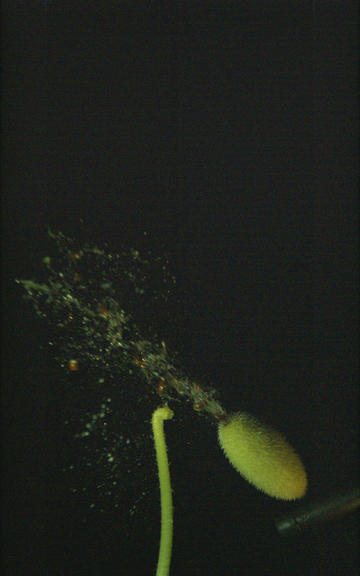The explosive secret of the squirting cucumber revealed
A team of researchers has solved a mystery that has intrigued scientists for centuries: how does the squirting cucumber squirt? The findings were achieved through a combination of experiments, high-speed videography, image analysis, and advanced mathematical modelling. The research was led by Oxford in collaboration with the University of Manchester.

A still showing the jet ejected from a squirting cucumber, which carries its seeds distances of up to 10m away from the mother plant.
Image: Dominic Vella
The squirting cucumber (Ecballium elaterium, from the Greek ‘ekballein,’ meaning to throw out) is named for the ballistic method the species uses to disperse its seeds. When ripe, the ovoid-shaped fruits detach from the stem and eject the seeds explosively in a high-pressure jet of mucilage. This projectile launch – lasting just 30 milliseconds – causes the seeds to reach speeds of around 20 metres per second, and land at distances up to 250 times the length of the fruit (around 10 metres).
Until now, the exact mechanism of the squirting cucumber’s seed dispersal – and how this affects its reproductive success – remained poorly understood. In the new study, researchers conducted a variety of experiments on Ecballium specimens grown at the Oxford Botanic Garden.
This included filming the seed dispersal using a high-speed camera (capturing up to 8600 frames per second), measuring fruit and stem volume before and after dispersal, performing indentation tests and CT scans of an intact cucumber, and monitoring the fruit with time-lapse photography in the days leading up to launch. They then developed a suite of mathematical models to describe the mechanics of the pressurised fruit, the stem, and the ballistic trajectories of the seeds.
Using this combined approach, the team untangled the key components of the plant’s dispersal strategy:
- A pressurised system: In the weeks leading up to seed dispersal, the fruits become highly pressurised due to a build-up of mucilaginous fluid.
- Fluid redistribution: In the days before dispersal, some of this fluid is redistributed from fruit to stem, making the stem longer, thicker and stiffer. This causes the fruit to rotate from being nearly vertical to an angle close to 45°, a key element needed for successful seed launch.
- A rapid recoil: In the first hundreds of microseconds of ejection, the tip of the stem recoils away from the fruit, causing the fruit to counter-rotate in the opposite direction.
- Variable launch: Due to the components above, the seeds are ejected with an exit speed and launch angle that depend on their sequence: with subsequent seeds, the exit speed decreases (because the pressure of the now emptying fruit capsule decreases) while the launch angle increases (due to the fruit’s rotation). This causes the initial seeds to reach the furthest distance, with subsequent seeds landing closer. As multiple fruits are distributed around the centre of the plant, the overall result is a wide and nearly uniform distribution of seeds covering a ring-shaped area at a distance of between 2 and 10 m from the mother plant.
Together, these components make up a sophisticated seed dispersal system. In particular, the redistribution of fluid from the fruit back into the stem is thought to be unique within the plant kingdom. Dr Chris Thorogood (Oxford Botanic Garden) said:
"For centuries people have asked how and why this extraordinary plant sends its seeds into the world in such a violent way. Now, as a team of biologists and mathematicians, we’ve finally begun to unravel this great botanical enigma."
Using the mathematical model, the researchers explored the consequences of artificially altering different parameters. This revealed that the seed projection method of the squirting cucumber has been fine-tuned to ensure near-optimal dispersal and the success of the plant over generations. For instance, making the stem thicker and stiffer resulted in the seeds being launched almost horizontally, since the fruit would rotate less during discharge. This would cause the seeds to be distributed over a narrower area, with fewer likely to survive. Meanwhile, reducing the amount of fluid redistributed from the fruit to the stem resulted in an over-pressurised fruit, causing the seed to be ejected at higher speeds but at a nearly vertical launch angle. Consequently, the seeds would not be dispersed far enough away from the parent plant, and again, few would survive.
Co-author Dr Derek Moulton (Oxford Mathematical Institute) said: "The first time we inspected this plant in the Botanic Garden, the seed launch was so fast that we weren’t sure that it had actually happened. It was very exciting to dig in and uncover the mechanism of this unique plant."
According to co-author Dr Finn Box, (University of Manchester), "This research offers potential applications in bio-inspired engineering and material science, particularly on-demand drug delivery systems, for instance microcapsules that eject nanoparticles where precise control of rapid, directional release is crucial."
Ecballium elaterium is a member of the gourd family (Cucurbitaceae) which also includes melon, pumpkin, squash, and courgette. The species is native to the Mediterranean, where – thanks to its effective seed-dispersal strategy – it is often regarded as weeds. The plant was even described by the ancient Greeks and Romans: naturalist Pliny the Elder (AD 23/24 – AD 79) said: "Unless, to prepare it, the cucumber be cut open before it is ripe, the seed spurts out, even endangering the eyes."
https://www.youtube.com/embed/saMjkchnzd0?si=bzE5Z5wQElYilymZ
To read more about this research, published in Proceedings of the National Academy of Sciences (PNAS), visit: https://doi.org/10.1073/pnas.2410420121

